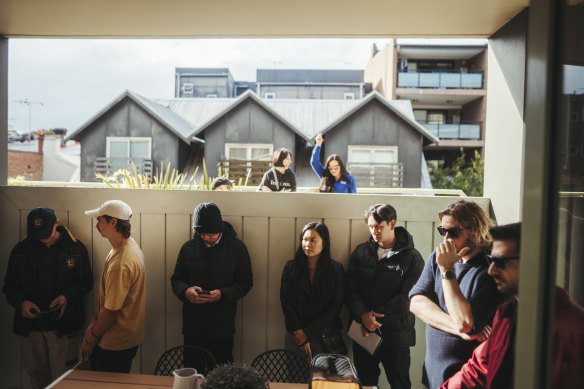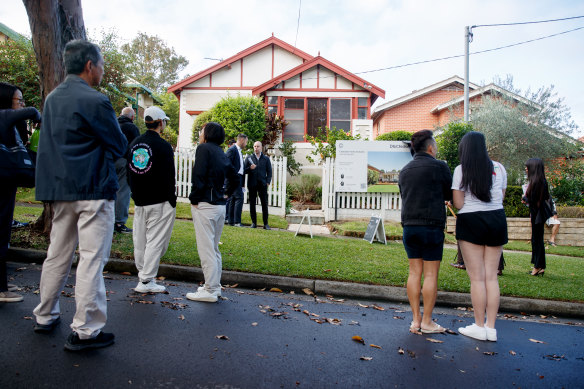‘People feel cheated’: Cut to home buyer budgets leaves households reeling
Australia’s cascading housing affordability crises have all but killed belief in the Great Australian Dream, experts say, as the average house becomes further out of reach of the average earner.
Even investment bankers are calling for rental reforms to support the growing ranks of long-term tenants as house prices far outpace capacity to pay.

Property prices have soared out of reach for many households.Credit: Dion Georgopoulos
A household where one partner earns the average income and the other works half the week could borrow enough money to buy a home worth $756,250, Canstar modelling shows. That assumes they save a deposit of $151,250 plus transaction costs including stamp duty.
A budget of that size would not stretch to the average house in any capital city except Hobart and Darwin.
If both partners work full-time their budget would stretch to $1,075,000, provided they could save a deposit of $215,000. This would just cover the median house in most cities except Sydney, where it would fall half a million dollars short.
For a single worker looking to buy a unit, their budget would be $465,000, which would not cover the median unit in any capital except for Perth and Darwin.
Home buyer budgets have been slashed over the past two years as 13 interest rate rises have pushed up mortgage repayments and reduced the amount banks are willing to lend.
This in turn has nudged a string of once-affordable suburbs out of reach, because property prices have not reduced in line with borrowing capacity.
“We effectively capitalised zero interest rates into house prices during the boom over 2021,” Jarden chief economist Carlos Cacho said.
“Since then we know that borrowing power has gone back by roughly 30 per cent, a little bit more or less depending on the household.
“The person who could afford to buy when rates were zero can no longer afford to buy.”
Prices have been supported thanks to recent wealthier buyers with access to family help, he said.
“This significant generational wealth transfer that has allowed people to enter the market that, arguably if it was just based on their income, they would struggle, but because they’ve been able to subsidise their income with cash or gifts or guarantees that’s allowed them to borrow.
“Unfortunately and sadly it means the average household can no longer afford the average home. You see across most of the capital cities you now need to be in the top 40 per cent of income earners to afford an average home if not higher in cities like Sydney, and that’s a big shift.”

Some buyers priced out of detached houses choose apartments or move further away.Credit: Nikki Short
Some were moving further away or choosing apartments instead of houses.
“For some it will mean home ownership will be delayed or perhaps not achieved. If we do see a rise over time of long-term renters, how do we adjust our regulatory settings.”
Demographer Simon Kuestenmacher said high house prices mean some workers give up on home ownership.
“People are pretty distressed about it. They stop believing in the Australian dream: The standard concept that you work hard – anyone should be able to work 50 hours a week, let’s make it a long week, should be able to have a decent quality of life, you afford a humble home and once a year you go on a trip to Bali,” The Demographics Group co-founder said.
“People feel cheated out of the absolute basics of life … you can’t out save the house price growth, so, ‘screw it, let’s not even try’.”
People may choose to rent instead and hope to inherit money from their parents when they’re close to retirement age, he said.
“How rich you need to be as a household by yourself without the bank of mum and dad to afford the down payment – it’s stupid, the system is broken.”
On a hopeful note, he said many young economists hope to tax wealth rather than income or consumption, which could point to the broad direction of future policy, such as moving from stamp duty to a broad-based land tax.
AMP chief economist Shane Oliver said it was very difficult for average households to purchase a home.
“The combination of very high house prices relative to people’s incomes along with the rapid rise in interest rates which have taken them back to levels last seen early last decade have resulted in a bit of a double whammy, dramatically blowing out the shortfall that an average home buyer would have in trying to get into the property market,” he said.
“There’s been a pool of buyers who can rely on the bank of mum and dad or they might have had excess savings built up through the pandemic.”
He said some buyers are moving out of Sydney and Melbourne, such as to Brisbane or Perth, to be able to buy a home.
He said more housing construction is needed to increase the supply of homes; normally high prices signal to builders to supply more, but more recently building costs have risen.
“Builders have been going bust,” he said.
“It’s hard to see how precisely it resolves itself.”